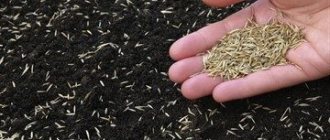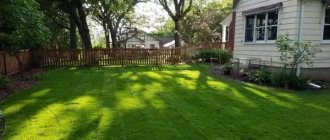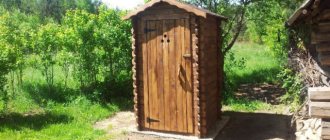Properties of lawn grass
There are two types of lawn grass:
- monoculture : one type of grass is planted, for example, meadow bluegrass;
- herbal mixture : a specially selected and precisely calibrated set of several herbs.
Grasses intended for seeding lawns have thin and delicate stems and leaves.
It is pleasant to walk on a grass carpet barefoot; this effect is achieved in the following ways:
- the so-called grasses that grow to a small height (50-70 cm) are predominantly used: they have a softer structure than the higher ones (from 100 cm);
- selection methods form delicate, velvety varieties.
Regular grass is quite tough, especially after cutting. Lawn grasses are perennial. Unlike one- and two-year-olds, they do not die off completely after the seeds ripen - only the fruiting (generative) shoot. When properly cared for, these grasses maintain grass cover for decades.
But seeds of plants with a short life period are also added to the mixture to speed up the formation of the lawn. After they die off, their place is taken by perennials. Perennial grasses, in turn, are divided into perennial, short-term and transitional. They can also be combined: short-term grasses grow quickly, but long-term grasses provide the lawn with a long service life.
Lawn made from grass mixture
Lawn perennials have a developed ability to tiller and form durable turf. The first condition makes the lawn thick and uniform, the second - resistant to weeds and mechanical stress. Lower grasses bush best, semi-upper grasses (70-100 cm tall) are a little worse, and upper grasses are weakly bushed.
This is another reason to use primarily grass grass mixtures for lawns. The strength of the turf depends on how the grass bushes. The type of tillering, in turn, is determined by the type of root system.
There are four types of root systems:
- rhizomatous;
- rhizome-loose bush;
- loose bush;
- dense bush.
The most dense, durable turf is formed by rhizome-loose bush grasses. Dense bushes are rarely used because they form hummocks when overgrown.
Due to their ability to tolerate moisture deficits well, they are planted in dry areas where other herbs cannot grow. Very few types of herbs have these properties. Therefore, when purchasing a grass mixture, you should check its composition.
Since each type of root system develops in its own soil zone, it is advisable to use mixtures of grasses with different roots: together they will permeate the environment in full.
How to choose seeds?
Seeds are selected taking into account the following factors:
- purpose of the lawn;
- climatic conditions in the region;
- other features: groundwater level, lighting, site slope, etc.
Lawns are divided into many types, and seeds are selected according to their purpose. An elite (parterre) lawn looks more presentable. But it requires careful care. The most valuable types of grasses are used - grassroots rhizomatous-loose bushes.
Most often these are meadow bluegrass, red fescue and common bentgrass. An ordinary garden lawn is designed for low maintenance, so grasses with a low growth rate (less often need cutting) and resistant to heat, cold, weeds, pests and diseases are used.
By height of growth - grassroots and some of the semi-upper ones, by type of root system - rhizomatous and loose bushes, most often these are:
- various types of fescue: red, reed, sheep;
- meadow bluegrass;
- bentgrass shoot-bearing or slender;
- perennial ryegrass.
The main requirement for a sports grass carpet is resistance to high loads, so varieties that form a durable coating are used:
- perennial ryegrass;
- clover;
- white bentgrass.
In mixtures for playgrounds, timothy grass is often used instead of bentgrass. Professionally maintained sports lawns, such as football fields and tennis courts, are usually planted with a monoculture of meadow grass.
A grass mixture is also used, where in addition to the mentioned plant, red fescue is present. When sowing a meadow lawn, legumes are included in the grass mixture.
The Moorish lawn is decorated with the addition of wildflowers, such as:
- field cornflower;
- oriental poppy;
- echinacea;
- meadow chamomile;
- nemesia;
- large-flowered flax;
- bells.
The listed plants are added most often. Bulbs that bloom in spring are also used: daffodils, crocuses, tulips. Data on climatic conditions, lighting and other factors for which this lawn grass is designed is indicated on the packaging.
The most common plants used to create lawns are:
meadow bluegrass . A rhizome-loose bush grass that grows on any soil except those with high acidity. You can deoxidize the soil with ground chalk, after which lime is added to it. Bluegrass is not afraid of wet areas, but when flooded it gets sick or dies. Due to the ability to create a reserve of nutrients in the underground part, it tolerates winters with severe frosts well. It has proven itself well on slopes, provided that red fescue is added to the mixture;- perennial ryegrass . Loose bush grass, lush, grows quickly - provided proper watering. Ryegrass does not tolerate drought, prolonged flooding, high groundwater levels and heavy clay soil. Thanks to its strong stems and turf and rapid growth, the seeds of the plant are added to repair grass mixtures and are readily used to prepare a sports lawn;
- red fescue . It has many subspecies; rhizome varieties are used for growing lawns. Has increased endurance. It grows on any soil, even the poorest, tolerates drought well and is able to develop with poor watering. Thanks to these properties, red fescue is an indispensable component of grass mixtures for difficult areas;
. Ground grass with a dense bushy root system. Like all dense bushes, it is drought-resistant: when the above-ground and underground parts dry out, it goes into hibernation and emerges from it when soil moisture normalizes. It grows slowly, but emerges from hibernation earlier than other herbs. Long-lasting, resistant to trampling, tolerates shearing well. But as it grows it forms hummocks. Suitable for organizing ordinary lawn coverings in arid regions;
sheep fescue- bentgrass . This grass spreads aggressively, sending out creeping shoots, making the development of weeds impossible. The roots are shallow, so it does not tolerate drought well. Loves loose sandy or loamy soil. Produces smaller seeds than other grasses.
By combining the listed herbs in different proportions, manufacturers have the opportunity to create lawn grass mixtures that are resistant to almost any climatic factors. For special conditions, other herbs are added. For example, oak grove bluegrass, which tolerates low light levels (penumbra).
It is recommended to purchase lawn grasses whose quality is confirmed by a certificate.
Features of proper sowing
It is advisable that the drawing up of a rough design for your future lawn should take place in the winter. Then, with the beginning of spring, you will immediately begin excavation work. Lawn mixtures show the best survival rate in early spring, when the soil is saturated with moisture and there is no intense heat. If the moment is missed, then you should not sow the lawn in the summer. Wait until the autumn days, when the rains saturate the soil, and then start sowing. But don’t be late: before winter, the young lawn should go away after 1-2 mowings.
You can learn more about how to prepare your lawn for winter from the material:
Preparing the soil for planting seeds
The work order is as follows:
- Clearing. First of all, the future site is cleared of all kinds of construction debris and stones. Stumps are uprooted and low-growing branches on trees are trimmed.
- Weed control. Then it’s time to control weeds. They must either be weeded out by hand, destroying them along with the roots, or chemically treated. In the first case, you will spend a lot of physical strength on destroying weeds, but you will be able to immediately begin the next stage of work. When using chemical weeding, you will have to wait at least a week until the drug begins to have a destructive effect. This is why it is recommended to treat the soil with chemicals in the fall. Then the weeds will disappear over the winter, and the chemicals themselves will have time to break down into safe elements and will not harm when planting the lawn.
- Creation of a drainage system. If your site is in a lowland, then you need to rid the soil of waterlogging. To do this, make sure there is drainage before digging up the lawn. After rain, mark places where water accumulates and dig deep holes (about a meter) in them. Line the bottom of the holes with broken bricks, then with coarse gravel, and over it with a layer of sand. Leave 40 cm for fertile soil. After planting, the water will go into the soil and through the ground into the drainage hole.
- Leveling the area and digging. In uneven areas, it is necessary to level the terrain so that the lawn has an even horizontal surface. To do this, stretch cords to pegs at different ends of the site and watch the level differences. The holes are filled up and the hummocks are cut off. After this, the entire area is dug up. Any roots of perennial weeds, debris and stones are removed. Sandy soils are fertilized with black soil or peat. Too fatty ones are diluted with sand.
- Tamping and loosening. Before planting lawn seeds, you need to compact the soil tightly, walking on it in small steps or using a board. They place it on the edge of the plot and jump on it until the ground settles. Then they move the board and continue until the entire area is trampled. You can also roll a thick log. As soon as you step on the ground and it doesn’t soften under your foot, the soil is ready for planting. All that remains is to loosen it slightly with a rake and sow it with a lawn mixture at the density recommended in the instructions.
After the earth is compacted, you need to move the top layer with a rake so that the seeds have access to air and moisture
What is better for the lawn: grass mixture or monoculture?
Let's compare both options.
Monoculture
Advantage: the lawn looks uniform in color and structure.
Disadvantage: any negative factor that is unacceptable for this monoculture destroys the entire lawn. Typically, monoculture is used on lawns with high quality requirements and professional maintenance.
These are fields for playing bandy and football, tennis courts, etc. Also, parterre lawns are grown from one or two types of grass, the appearance and quality of which are also subject to high demands.
Grass mixture
It does not have such a uniform appearance as a monoculture, but it is more resistant to negative factors. This is explained by the fact that each factor that is unacceptable for one component of the mixture is easily tolerated by other components.
Thus, grass mixtures are recommended to be used:
- when creating lawns “with your own hands”, that is, amateur ones: it is more difficult for a non-professional to correctly assess all the features of the climate and soil, as well as accurately carry out the correct care;
- in problem areas.
The properties of the grass mixture and its resistance to certain negative factors depend not only on the composition, but also on the ratio of the components in it (proportions).
Lawn planting dates by region and according to the lunar calendar in the spring of 2022
The lawn should only be seeded after the snow has melted. In this case, the soil must remain moist. In each region, sowing dates are different.
For example, in the south lawn planting occurs at the beginning or end of March .
In the middle zone , it is recommended to start planting grass mixtures in April .
In Siberia and the Urals, sowing is carried out in late April-early May .
In the northwestern regions, the lawn is planted in May .
When determining a suitable date, many summer residents rely on the Lunar calendar.
Favorable days for sowing a lawn in the spring of 2022 (you need to focus on your region and weather):
- March: 6-8, 11-13, 16, 19-22, 25, 26, 29, 30;
- April : 3-4, 8, 9, 13-15, 18, 21, 22, 25 (from 13:15)-27 (until 19:10);
- May : 5-7, 10, 11, 22 (from 18:50)-24, 27-29 (until 20:24).
Unfavorable and prohibited days for planting a lawn according to the Lunar calendar:
- March: 2, 3, 4-6, 14,15, 17, 18, 31;
- April : 1 , 10-12 (until 17:08), 16 , 17 , 23-25 (until 13:15), 28-29, 30 ;
- May : 1 , 7 (from 14:51) - 9, 15 , 16 , 20 (from 15:53) - 22 (until 18:50), 29, 30 , 31.
On other days, it is generally possible to sow a lawn, but supporters of the Lunar calendar recommend doing this only on favorable days.
Types of grass mixtures
By selecting various plants and combining them in different proportions, producers obtain herbal mixtures with one or another feature.
Here are the most common types of grass mixtures:
- fast . They develop in the shortest possible time. This is important when restoring damaged areas of the lawn, which is why quick grass mixtures are often used as repair ones. Their main components are usually meadow bluegrass, meadow timothy or meadow fescue. The disadvantage of fast grasses is that they are short-lived, that is, they live relatively short lives. Perennial grasses grow slowly. By mixing both types, they achieve mutual compensation for shortcomings;
- shadow . Such mixtures specialize in poorly lit areas. The main component can be bluegrass, perennial ryegrass or red fescue;
- solar _ They love light and can stay in the open sun all day long. They also tolerate drought well. Representatives: meadow bluegrass, hop alfalfa, sheep fescue;
- universal . This mixture develops and forms a full-fledged healthy lawn in a wide range of conditions, so it is suitable for almost any site. The basis is often bentgrass, which successfully withstands severe frost, heat and prolonged drought. The peculiarity of this grass is its slow regrowth after cutting.
Watering
The lawn requires frequent watering, otherwise the grass may burn out in dry, hot weather. Water with a hose or using a sprinkler. It is better to water in the evening, 1-2 times a week, abundantly, to thoroughly moisten the roots and soil.
View everything you need for watering →
Features of varieties:
If bentgrass predominates in the mixture, water every other day. Ryegrass, fescue, and bluegrass can be watered less frequently; if rainfall is frequent, natural watering is sufficient. In a well-groomed, strong lawn, weeds do not take root; after cutting, the weed seedlings die.











